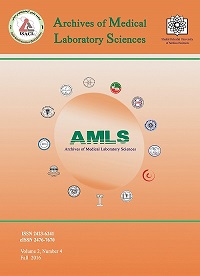Significant Relationship between Salivary and Serum β2-Microglobulin in Prostate Cancer and Benign Prostatic Hyperplasia Patients
Archives of Medical Laboratory Sciences,
Vol. 2 No. 4 (2016),
16 April 2017
https://doi.org/10.22037/amls.v2i4.17184
Abstract
Background: The presence of beta-2microglobulin (β2M) in biological fluids due to lack of binding to the membrane, increases at the time of cell turnover such as cancer and chronic infectious. In recent years, study on the standardization of saliva for clinical diagnosis is increased. The objective of this study was to determine β2M levels and the relationship between salivary and serum β2M in Prostate cancer (PCa) and Benign prostatic hyperplasia (BPH) patients.
Materials and Methods: In a case-control study, forty Subjects including 20 PCa and 20 BPH were enrolled. The concentration of β2M was measured by an enzyme-linked immunosorbent assay. The comparison between β2M levels in the PCa and BPH groups as well as the correlation between salivary and serum β2M were tested using Mann-Whitney U test and spearman correlation coefficient, respectively.
Results: Statistically significant difference was observed between salivary and serum β2M in the PCa and BPH groups (P<0.05). Spearman correlation analysis showed that salivary β2M is correlated positive and significantly with serum β2M in the PCa (r = 0.747, P < 0.05) and BPH (r = 0.513, P < 0.05) groups.
Conclusion: β2M can be a suitable biomarker for the diagnosis of prostate diseases, as well as salivary β2M can be used as an alternative approach to serum β2M for monitoring and diagnosis of prostate diseases.
- Beta-2 microglobulin
- Saliva
- Prostate cancer
- Benign prostatic hyperplasia
How to Cite
References
Nemer AMA, Aldamanhori RB. Prostatic diseases under focus in a university hospital in Eastern Saudi Arabia: A 15-year experience. Saudi Medical Journal. 2015;36(11):1319-23.
Abdel-Meguid TA, Mosli HA, Al-Maghrabi JA. Prostate inflammation. Association with benign prostatic hyperplasia and prostate cancer. Saudi Med J. 2009;30(12):1563-7.
Carter HB, Albertsen PC, Barry MJ, Etzioni R, Freedland SJ, Greene KL, et al. Early detection of prostate cancer: AUA Guideline. The Journal of urology. 2013;190(2):419-26.
Leidinger P, Hart M, Backes C, Rheinheimer S, Keck B, Wullich B, et al. Differential blood-based diagnosis between benign prostatic hyperplasia and prostate cancer: miRNA as source for biomarkers independent of PSA level, Gleason score, or TNM status. Tumor Biology. 2016;37(8):10177-85.
Hovels AM, Heesakkers RA, Adang EM, Jager GJ, Strum S, Hoogeveen YL, et al. The diagnostic accuracy of CT and MRI in the staging of pelvic lymph nodes in patients with prostate cancer: a meta-analysis. Clin Radiol. 2008;63(4):387-95.
Shariat SF, Semjonow A, Lilja H, Savage C, Vickers AJ, Bjartell A. Tumor markers in prostate cancer I: blood-based markers. Acta oncologica (Stockholm, Sweden). 2011;50(Suppl 1):61-75.
Prizment AE, Linabery AM, Lutsey PL, Selvin E, Nelson HH, Folsom AR, et al. Circulating Beta-2 Microglobulin and Risk of Cancer: The Atherosclerosis Risk in Communities Study (ARIC). Cancer Epidemiol Biomarkers Prev. 2016;25(4):657-64.
Shiiki N, Tokuyama S, Sato C, Kondo Y, Saruta J, Mori Y, et al. Association between saliva PSA and serum PSA in conditions with prostate adenocarcinoma. Biomarkers. 2011;16(6):498-503.
Laidi F, Bouziane A, Lakhdar A, Khabouze S, Amrani M, Rhrab B, et al. Significant correlation between salivary and serum Ca 15-3 in healthy women and breast cancer patients. Asian Pac J Cancer Prev. 2014;15(11):4659-62.
Chen DX, Schwartz PE, Li FQ. Saliva and serum CA 125 assays for detecting malignant ovarian tumors. Obstet Gynecol. 1990;75(4):701-4.
Liu J, Duan Y. Saliva: A potential media for disease diagnostics and monitoring. Oral oncology. 2012;48(7):569-77.
Abdul M, Hoosein N, editors. Changes in beta-2 microglobulin expression in prostate cancer. Urologic Oncology: Seminars and Original Investigations; 2000: Elsevier.
Segal A, Wong DT. Salivary diagnostics: enhancing disease detection and making medicine better. Eur J Dent Educ. 2008;1:22-9.
Liu J, Duan Y. Saliva: a potential media for disease diagnostics and monitoring. Oral Oncol. 2012;48(7):569-77.
Prizment AE, Linabery AM, Lutsey PL, Selvin E, Nelson HH, Folsom AR, et al. Circulating beta-2 microglobulin and risk ofcancer: the Atherosclerosis Risk in Communities Study (ARIC). Cancer Epidemiology and Prevention Biomarkers. 2016:cebp. 0849.2015.
Gross M, Top I, Laux I, Katz J, Curran J, Tindell C, et al. β-2-microglobulin is an androgen-regulated secreted protein elevated in serum of patients with advanced prostate cancer. Clinical Cancer Research. 2007;13(7):1979-86.
Abdul M, Banks M, Hoosein N. Urinary markers for prostate cancer. International journal of oncology. 1996;8(4):735-40.
Assareh AA, Haybar H, Malekzadeh H, Yazdanpanah L, Bozorgmanesh M. No Relationship between Serum and Salivary β2-Microglobulin Levels in A Sample of Adult Diabetic Men with Chronic Kidney Disease without Renal Replacement Therapy. Cell Journal (Yakhteh). 2014;16(2):179.
Vahedi M, Malekzadeh H, Haybar H, Soltanian AR, Abdollahzadeh S, Yoosefi H, et al. The relationship between salivary beta-2 microglobulin and uremia intensity in men with chronic renal failure. Cell Journal (Yakhteh). 2013;14(4):276.
Laidi F, Bouziane A, Lakhdar A, Khabouze S, Amrani M, Rhrab B, et al. Significant correlation between salivary and serum Ca 15-3 in healthy women and breast cancer patients. Asian Pac J Cancer Prev. 2014;15(11):4659-62.
Agha-Hosseini F, Mirzaii-Dizgah I, Rahimi A, Seilanian-Toosi M. Correlation of serum and salivary CA125 levels in patients with breast cancer. J Contemp Dent Pract. 2009;10(6):E001-8.
Mirzaii‐Dizgah I, Jafari‐Sabet M. Unstimulated whole saliva creatine phosphokinase in acute myocardial infarction. Oral diseases. 2011;17(6):597-600.
- Abstract Viewed: 320 times
- PDF Downloaded: 233 times
